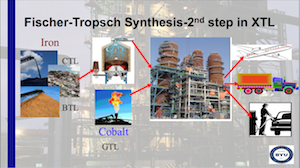Catalysis Research
Fischer-Tropsch Synthesis: Kinetics of Cobalt Catalysts

Faculty: Morris D. Argyle
Fischer-Tropsch Synthesis (FTS) is the catalyzed conversion of synthesis gas (CO + H2) obtain from natural gas, coal, or biomass to a variety of hydrocarbons from C1 to C50. With the current high price of oil, interest has grown in finding petroleum-similar energy sources such as FTS fuels. Typical catalysts used for FTS consist of 20-30% cobalt supported on a high surface area oxide support such as alumina and promoted with a noble metal such as Pt or Ru. Due to the cost of these material, catalyst longevity is a critical property in designing and operating FTS processes. The Hecker research group is doing experimental and modeling studies of the deactivation behavior cobalt FTS catalysts. They study the kinetic behavior in experiments that last up to 800 h, and then analyze the spent catalysts to determine the cause of catalyst decay. Experimental techniques used include BET, TGA, TPR, TPO, TPH, TEM, EXAFS, XRD, chemisorption, and fixed-bed activity/selectivity testing.
Fischer-Tropsch Synthesis: Development of Novel Iron Catalysts

Faculty: Morris D. Argyle
While supported Co and unsupported Fe catalysts are the catalysts most used in commercial FT plants, supported Fe has potential advantages over Co including lower cost, higher water-gas shift activity, and greater stability. The Hecker group has developed a state of the art supported Fe catalyst by using a novel support material with superior pore properties, advanced preparation techniques, and a silica promoter to produce a catalyst with superior activity and stability. They continue to do research to improve the product distribution including trying to produce more gasoline and diesel range hydrocarbons and less methane.
They have also developed a method to prepare unsupported Fe catalysts using a novel solvent- deficient precipitation (SDP) technique which allows one to mix dry powders and with the aid of the waters of hydration prepare a very excellent Fe FTS catalyst.
UV Spectroscopy of Fe-La Cataysts for Hydrogen Production

Faculty: Morris D. Argyle
Production of chemical grade hydrogen presents several challenges. There is no hydrogen well or mine like there is for natural gas or coal. The hydrogen atoms need to be stripped off of hydrocarbons or water in order to produce the gas. Their research involves using an iron lanthanum catalyst in order to improve the reaction rate of the hydrogen production process. By utilizing a diffuse reflectance UV vis spectrometer, they are measuring various reaction characteristics of this process.
Biocatalysis

Faculty: Dean R. Wheeler, William G. Pitt
Dr. William Pitt, in conjunction with Dr. Dean Wheeler of Chemical & Biological Engineering and Dr. Gary Watt of Chemistry at BYU, is developing biocatalysts that can be used in fuel cells to convert carbohydrates, such as glucose, into electricity. The catalysts are from the viologen family of redox molecules. Dr. Pitt and his students are attaching various types of viologens to conductive graphite surfaces for use in fuel cells.
Enzyme-Mediated Biocatalysis

Faculty: Brad C. Bundy
Dr. Brad Bundy's lab is researching the development of sustainable biocatalysts with increased stability, reusability, and specificity by controlling the orientation of covalently immobilized enzymes.
More information: